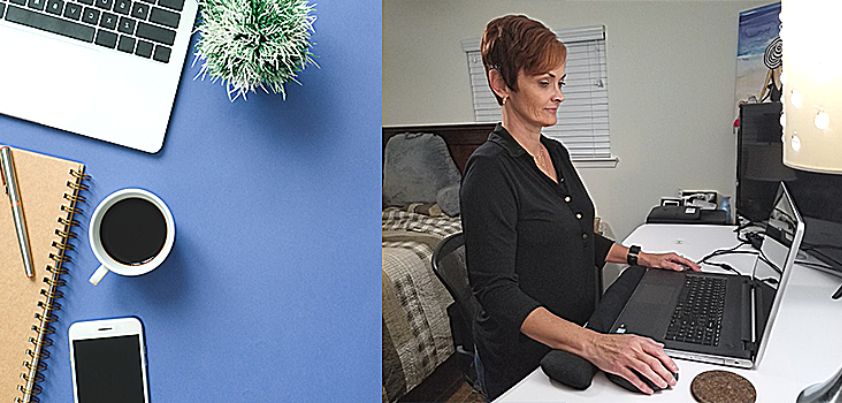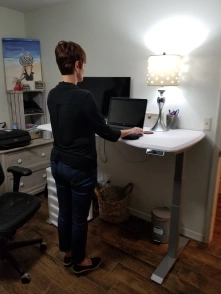Proper Mindset, Workspace Setup, Lighting Lead to a Safe and Successful Remote Work Environment

As a result of widespread remote working conditions amid the coronavirus pandemic, the daily commutes for many people can now be measured in feet rather than miles.
And while it might be tempting to spend the day working from the couch, improper seating and working habits can have long-term impacts on your health, says UMGC Associate Collegiate Professor Vicki Seal.
Seal, who teaches occupational safety and health (OSH) in the undergraduate Environmental Management program, spent 25 years doing OSH assessments for the U.S. Air Force.
She has also worked from home for more than five years and knows firsthand that a typical workday on-site is very different than one under remote conditions.
“You get up and go to meetings, you go to lunch–you tend to get away from your desk more than you do at home,” Seal said.
Here are her recommendations for protecting your physical, visual, and mental health when working from home:
Plan Your Attire and Workspace Location
Even though for many “business casual” has become just “casual,” changing into a designated “work” outfit can help create a mental separation between work and personal life when both are happening in the same place.
It may be convenient to go to work in your pajamas, Seal said. But, she added, “I’ve learned in the long run that leads to me feeling mentally a lot worse.”
For the same reason, she said it is also ideal to designate a work area in your home that—unlike the kitchen or coffee table—is not regularly used for other purposes.
Consider Your Workspace Setup
Among the biggest considerations when setting up your home workspace are ensuring proper posture and minimizing the risk of injuries that can result from repetitive motions.

When setting up a remote workspace in your home, Seal said, it is important to consider your seated posture in relation to your keyboard and computer monitor or laptop screen.
“You need your feet flat on the floor, arms at 90-degree angles,” when working from a seated position, explained Seal. Computer screens or monitors should be at or just below eye-level, ideally using a laptop stand or monitor mount with an external keyboard. She added that periodically one should be able to change between a sitting and standing position.
“When you’re building inflammation in your body, that’s when you have a problem,” Seal said.
While adjustable desks are the “gold standard” for easily transitioning between sitting and standing, she said a kitchen counter or home bar can also be used to facilitate working from a standing position.
Regardless of how frequently you change working positions, also make sure to step away from the computer periodically.
“Taking breaks frequently is really important to keep your muscles moving around,” said Seal.
Visibility and Lighting

While adjustable desks are a great way to transition between sitting and standing while working, Seal said a kitchen counter or home bar can also be used to help you change positions periodically.
Computer screens are not the only thing that should be at eye level when working. Seal said that it is worth elevating anything that is referenced repeatedly throughout the workday to avoid repetitive-motion injuries from looking down and back up.
A bookstand, like one she uses to hold printed materials when writing curriculum, can make all the difference she said.
Most people do not have the benefit of overhead office lighting in their homes, which means it is also important to ensure remote workspaces are well-lit.
Seal said that anyone working from home should have task lighting, such as a desktop lamp “that gives you light directly on whatever you’re trying to reference.”
Using a larger external monitor with one’s work computer can also make the remote working experience easier on the eyes.
Regardless of what measures are taken to enhance lighting and visibility, eyestrain is inevitable if you focus on anything for too long, Seal said.
“You need to take a break before it starts to hurt.”
Photo Credits: Photos courtesy of Vicki Seal.
Editor’s note: This article by Thomas Moriarty originally ran on the university’s internal ENGAGE website for UMGC students, faculty members and staff. It appears here in a revised form on the Global Media Center, UMGC’s external news and information site.

Share This